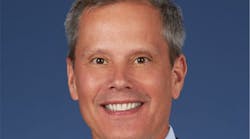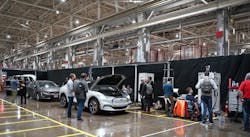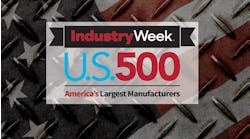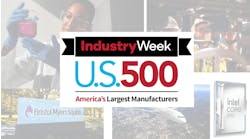Lincoln Electric has been a rock-solid manufacturer of industrial and consumer welding equipment for many years. The company doesn’t usually make waves, unless it's with the red-and-black, muscle-car-color-combo of its welders or the renewable energy from the giant wind turbine beside its Euclid, Ohio, headquarters. But 128-year-old Lincoln got some major attention recently when it announced its power welding technology would be perfect for a more current use: DC fast chargers for electric vehicles.
Under the leadership of Chris Mapes, CEO since 2012, Lincoln has increased its global reach and product offerings, prioritized training welders as well as making welding equipment and innovating around the manufacture of electric-vehicle chargers.
Steve Hedlund, Lincoln’s chief operating officer since 2022, has been behind-the-scenes but very involved in these projects. In October, Lincoln announced that Hedlund would be taking over as president and CEO in January 2024, with Mapes retiring and serving as executive chairman of the Board. It’s a leader-succession plan that has been in the works for a number of years now—like a lot of things at Lincoln, reasoned, deliberate but also forward-facing.
Hedlund, who held high-level leadership roles at Lincoln since 2008 and before that was in strategy and M&A at Fortune Brands and the consulting firm Booz Allen & Hamilton, recently talked to IndustryWeek at the 2023 North American Testival, held at Lincoln at the end of November. Put together by global e-mobility association CharIN, Testival was a big international event where engineers from Tesla, BMW, Ford, Lucid, Rivian, Navistar, Audi came to test the interoperability of vehicles, charging stations and communications controls. Charger manufacturers included ABB, EVgo, and yes, Lincoln.
With much of the technology and manufacturing capability already in-house, Lincoln is gunning for Infrastructure Investment Act incentives for electric chargers that require manufacturing a significant percentage of the charger components in the U.S.
Hedge talked with IndustryWeek about his leadership transition and what’s ahead for Lincoln Electric.
IndustryWeek: What’s the transition from COO to CEO been like for you?
Steve Hedlund: The transition was well-orchestrated and telegraphed in advance. There hasn’t been much shock in the organization. But I’m starting to get a lot more involved in the broader stakeholders of the company, groups like the Manufacturer’s Alliance and the business organizations in Northeast Ohio that I wouldn't have had much exposure to before.
And my relationship with the Board of Directors is changing. I've been in every board meeting for the last 15 years presenting something. I started at Lincoln in strategy and acquisitions, and I ran some of the business units. So I've always had some engagement, interaction with the board, but now that they're my boss, it's a little different. So it's nuances like that, that are changing.
IW: What do you see as the future of the DC chargers?
Hopefully, it'll be a very bright future. We're solving an industry pain point that nobody other than Tesla has been able to solve so far, which is the reliability of, basically, an industrial computer that's managing high power loads out in extreme environmental conditions. We know how to do that because that's what a welder is. And we make products for use in the Saudi Arabian desert and the steel foundry, and we're doing offshore oil and gas equipment in Alaska. So we're used to that sort of environmental challenge, and the need to make products that are incredibly robust and reliable and durable.
We're using those same skills and competencies to design and manufacture this product in this industry segment. And everything that we hear from people who are participating in the market today is that the world desperately needs what we can bring to the party. So we're pretty excited about it.
It's been a sprint to get to this point of launching them in production. We really only started making [the DC chargers] 18 months ago, initially with a proof of concept where we sort of jury-rigged a welder to make it charge a car. And that was the proof of concept. Since then, it's been about a 12-month sprint to get that initial design more industrialized to be produced in volume to be much more robust than the initial prototype was.
IW: What do you see as the demand? Your operations manager talked about manufacturing 1,000 units in first year, and then increasing that to 6,000. That seems like a small amount to an outsider like me looking in.
The answer is I have no earthly idea only because there's so many other factors, either outside our control or even outside our customers' control that will pace the rollout. And so it's things like availability of grid connections, availability of transformers and switchgear, civil permitting, civil construction works. I've been very cautious to tell investors and our board and other stakeholders that look, this is the capacity we're putting in place; I have no idea how quickly we will fill that capacity. If we get to the point where we need more capacity, we've got the opportunity to continue expanding to keep pace with demand. But I just don't know how fast it's going to come.
IW: What are you hearing?
Well, the great thing is, we want this initiative to be successful, we expect it will be successful, but we don't need it to be successful. This is not our only business, right? So if something happens, and the federal government infrastructure act money rolls out more slowly than people expect, it's not like we'll have a cash flow problem We're not going to be struggling to make payroll. We'll just keep focused on developing the best product we can.
It's really an upside opportunity for us. It gives us the ability to say, “Look, I don't know what demand will be—this is my capacity if and when I fill it, great, because it's not like we are going to close the doors if we can't sell them.
The feedback we've gotten from prospective customers has been incredibly supportive. They understand who we are and what we do, they understand why we're getting into this business, they feel like we're addressing a pain point for them. They're a little bit once-bitten, twice shy, “I've bought equipment that didn't work so I like your story. But I want to see one feel one test one, I want to see all the test data before I'm willing to commit to purchasing.” That's why it's been such a sprint to get to this moment where we can now make actual production units to give to people to test and validate. And so we’ll really be focused in the first half of 2024 on getting that done.
IW: Are you able to find people with the skills to staff the DC charger operation?
The only problem we have is that everybody in the company wants to work on this project. So, it's a constant battle to remind people that the welding business is actually what's paying the bills. We can't ignore that. But it's been very invigorating, I think, for the employees to see that the company has a future in extending what it can do into other markets. We're not just a welding company anymore because we have this initiative, which we're very excited about. We're also getting into additive manufacturing, using our welding know-how and a welding robot to basically act as a 3D printer to print parts from scratch. I think a lot of employees look at that and say, "This isn't your father's Lincoln Electric, right, this is a new Lincoln Electric, that is much more future forward in its outlook, but yet very honored of its past heritage.” I think it's an exciting time to be in the company.
IW: What strategic changes are ahead for the rest of the business?
The core welding business will just keep more of the same innovation to make the welding process easier, more productive, more fault-tolerant for customers. There's a huge shortage in the world of skilled welders. And so a lot of our customers are looking to us to help them--how do I make product with a lower skilled workforce? Or if I can't get the labor, how can I automate my process, so I can keep my production up in the face of all that. So we'll just keep pushing the gas pedal on that part of the business as well.
IW: Do you see any mergers and acquisitions?
Absolutely. We are blessed with a very strong balance sheet and very good cash flow. So we're continually looking for companies that can help either get us into new markets or extend our competency and capabilities and in fit with who we are.
IW: Are you looking to acquire startups in the charging space?
Yeah, that's interesting. You know, a lot of companies are really hitting the wall. Now that the interest rate environment has changed, the era of free money is over. And so we look at a lot of those, but we look at it with a very skeptical eye of, “Does this really help us advance the ball? Or are we just taking on somebody else's problems to get things?” And so far, the answer has been we'd be taking on someone else's problems. We don't need that headache right now. But never say never.






